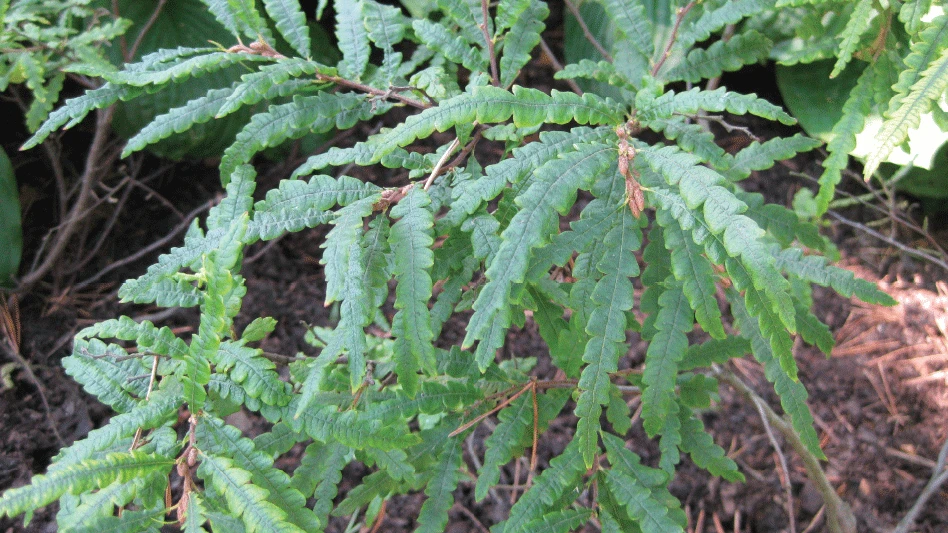 The easiest way to describe Schizophragma hydrangeoides, Japanese hydrangea vine, is as a kissin' cousin to Hydrangea anomala ssp. petiolaris, the more common climbing hydrangea. S. hydrangeoides is a deciduous, vigorous climbing, clinging vine that can climb up walls, trees, fences and anything else that stands still long enough.
The easiest way to describe Schizophragma hydrangeoides, Japanese hydrangea vine, is as a kissin' cousin to Hydrangea anomala ssp. petiolaris, the more common climbing hydrangea. S. hydrangeoides is a deciduous, vigorous climbing, clinging vine that can climb up walls, trees, fences and anything else that stands still long enough.
Not that it's overly aggressive. In fact, it might even need a little help getting started on its climb. But once it gets going, the straight species can climb up the better part of a good-sized oak.
This species has an early-summer display of delightful creamy-white inflorescences that, at first glance, look quite similar to climbing hydrangea, although the two species are easily distinguished. First, both produce showy masses of fertile flowers set off by showy sepals.
In the case of H. a. ssp. petiolaris, the sepals are multiparted (three to five) whereas in Schizophragma, the sepals are singular, ovate and significantly larger (up to 1 inch or more long), yielding a much more robust appearance. Neither has an overpowering fragrance. In general, each Schizophragma inflorescence can grow to 6-8 inches across, slightly larger than its cousin.
Wow the crowd
I recently herded a group past a wonderful specimen at the Scott Arboretum and the gasps and sighs abounded. However, as wonderful a plant as the straight species is, the cultivar 'Roseum' is definitely worth the extra effort.
Although slightly less vigorous than the species, the buttery soft-pink sepals are nothing short of magnificent. They start deep pink and rather small and over the course of a week or so seem to slowly inflate to their full extent as they fade to a softer hue.
The specimen in my garden is growing on the chimney along my driveway. Watching the sepals grow larger with each passing day was almost like watching a Chia Pet grow on the windowsill.
Schizophragma foliage is alternate, thick and leathery, broadly ovate with a strongly cordate base. The toothing along the margin is significantly more sparse than Hydrangea. Schizophragma fall color is delicate yellow and it's susceptible to the occasional Japanese beetle feeding frenzy.
Simple to grow
Culture is quite simple for Schizophragma. Provided with any reasonable soil texture and moisture regimen, the plant will grow quite rapidly. In my garden, I have the cultivars 'Brookside Littleleaf,' 'Roseum' and 'Moonlight.' Growth rate is least with the first listed and greatest with the last.
In general, I find that when compared with climbing hydrangea, S. hydrangeoides and all its cultivars get up and going in the garden more quickly and reliably. With the exception of 'Brookside Littleleaf,' flowering on young plants tends to be more reliable also.
All Schizophragma species and cultivars seem to propagate quite easily from cuttings just about any time the plant is putting on new growth. I've rooted various species and cultivars using indolebutyric acid concentrations ranging from 1,000-8,000 parts per million, and have even gotten some to root when taken as late as mid-September.
Enterprising propagators might like to sow seed of the pink form and see what they can do with darker forms.
- Paul Cappiello
Bernheim Arboretum and
Specifics
Name: Miscanthus sinensis 'Zebrinus'
Common names: Zebra grass, Japanese silver grass.
Family: Gramineae.
Description: Versatile ornamental grass; shrublike specimens grow in arching fashion to 6-7 feet tall, 5-10 feet wide.
Landscape uses: Accent, specimen, grouping, mass or screen, borders, meadows, wild gardens, cottage gardens, naturalized areas or pond/water garden peripheries.
Photo by Paul Cappiello
Get curated news on YOUR industry.
Enter your email to receive our newsletters.
Latest from Nursery Management
- How impending tariffs and USDA layoffs impact the horticulture industry
- Shifting the urban environment
- These companies are utilizing plastic alternatives to reduce horticultural waste
- How to create a sustainable plant nursery
- Lamiastrum galeobdolon ‘Herman’s Pride’
- One of rarest plants on earth: Tahina spectabilis
- Leading Women of Horticulture: Angela Labrum, Bailey Nurseries
- Get to know Pat Reilly with NewGen Boxwood and the American Boxwood Society






